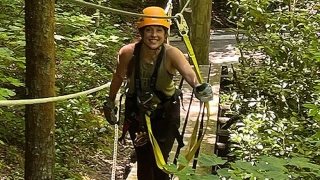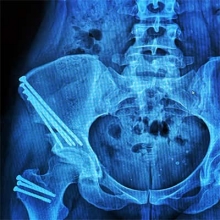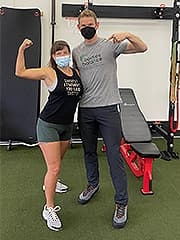Surgery for Acetabular Dysplasia and Femoral Head Cyst: Lauren’s Story
Published on
Published on
It’s not every day that a 38-year-old travels 400 miles to have complex hip reconstructive surgery at a children’s hospital, but that’s exactly what happened to Lauren. Here, she shares her unique perspective as an adult undergoing surgery and rehabilitation at Children’s Hospital of Philadelphia – and why she’d recommend it to other young adults with acetabular dysplasia and femoral head damage.
 Lauren had an active lifestyle until hip pain from acetabular dysplasia sidelined her.
My earliest symptoms happened when I was training with the military. I heard a clicking noise in my hip, my hip locked in position, I had groin pain and soreness on the side of my hip and pelvic area. I had weakness and limited flexibility in my right leg, and stiffness when I was sitting – to the point of being extremely painful when attempting to stand. I started to limp, and it got increasingly worse.
Lauren had an active lifestyle until hip pain from acetabular dysplasia sidelined her.
My earliest symptoms happened when I was training with the military. I heard a clicking noise in my hip, my hip locked in position, I had groin pain and soreness on the side of my hip and pelvic area. I had weakness and limited flexibility in my right leg, and stiffness when I was sitting – to the point of being extremely painful when attempting to stand. I started to limp, and it got increasingly worse.
It was hard to pinpoint exactly what was exactly causing it. Often, I would wake up at 4 a.m. in pain if I had lifted weights or ran stairs for my workout. I began to really start paying attention to what my body was saying.
Over time, my pain would last for longer periods of time and nothing I was doing could fix it: not stretching, over-the-counter pain medications, prescription medications, yoga or strengthening. It just seemed to hurt no matter what I tried and would not improve.
I saw a doctor in Raleigh, NC, in the summer of 2019. I was diagnosed with a torn labrum and had surgery in September. Things went well with surgery – or so we thought.
Ten months later, I was experiencing lingering pain in my hip and some different pains, so I had another MRI. This time, doctors saw damage to the femoral head (where the right femur met the hip socket). They knew this was more serious and referred me to another hip surgeon in Durham, NC.
Both doctors recommended I get a hip revision with allografts – using bone from my own body to strengthen the joint – rather than a total hip replacement but neither had performed the operation before. They referred me to Wudbhav N. Sankar, MD, at the University of Pennsylvania and Children’s Hospital of Philadelphia (CHOP), where he’s director of the Young Adult Hip Preservation Program. In July 2021, I underwent surgery at CHOP.
 An X-ray of Lauren’s hip and thigh shows where surgeons added pins and screws to hold her hip in the correct position after periacetabular osteotomy surgery.
I had an allograft of the femoral head for subchondral lesions and a periacetabular osteotomy (PAO). I describe it to my family as lesions in my bone that were like water pockets causing my bone to weaken at a faster rate, and I also had my hip socket repositioned.
An X-ray of Lauren’s hip and thigh shows where surgeons added pins and screws to hold her hip in the correct position after periacetabular osteotomy surgery.
I had an allograft of the femoral head for subchondral lesions and a periacetabular osteotomy (PAO). I describe it to my family as lesions in my bone that were like water pockets causing my bone to weaken at a faster rate, and I also had my hip socket repositioned.
I was active and still had a lot of things I enjoyed doing. I wasn’t ready to throw in the towel to my body falling apart.
I wanted my quality of life back and my two options were to try this surgery or get a hip replacement. Hip replacement would’ve been fine to start with but, given my age, I would’ve had to have additional ones and those would rob me of my quality of life. Plus, the younger you are when you have a hip replacement the faster the parts wear out. When you have additional hip replacements you are trying to attach larger pieces of metal to even smaller pieces of bone and there is no guarantee what kind of life you would have at that point.
I wasn’t ready to give up and I had the determination to put in the hard work of recovery to have a better quality of life long-term. Perhaps I also underestimated just how hard recovery would be, but that worked in my favor in a way. Dr. Sankar told me it would be a hard road, but that he often took care of adults at Children’s Hospital. The bonus of being at a children’s hospital was how gentle and patient they were with me. Frankly, I’d prefer a children’s hospital for every procedure now!
 Lauren is getting stronger everyday! Here, she poses with one of her physical therapists.
This was the hardest recovery I have ever had to go through (even harder than USAF boot camp), and it took much mental fortitude. A warrior mindset is necessary! After two months of no weigh bearing, I started physical therapy (PT) to learn to walk again. I remained in PT for a full year and now I’m finishing my strength and flexibility training at home. For me, self-discipline and a positive attitude made this experience possible. I knew it was going to be hard. If I had expected it to be easy, I’d have shed many more tears in those tough moments and possibly given up. One thing that really helped me was a continuous passive motion (CPM) machine. That made my leg feel so much better!
Lauren is getting stronger everyday! Here, she poses with one of her physical therapists.
This was the hardest recovery I have ever had to go through (even harder than USAF boot camp), and it took much mental fortitude. A warrior mindset is necessary! After two months of no weigh bearing, I started physical therapy (PT) to learn to walk again. I remained in PT for a full year and now I’m finishing my strength and flexibility training at home. For me, self-discipline and a positive attitude made this experience possible. I knew it was going to be hard. If I had expected it to be easy, I’d have shed many more tears in those tough moments and possibly given up. One thing that really helped me was a continuous passive motion (CPM) machine. That made my leg feel so much better!
My outcome has been a long road of hard work, but we’re not done yet. I am back to running now. I am looking forward to getting back to all my activities with no restrictions. I’m even opening a fitness-based business! Having the surgical hardware removed has made big improvements in my recovery and relieved a lot of my bursitis pain. I have 50% strength back in my leg compared to my non-surgical leg and I am slowly gaining my flexibility back. I am still progressing. It’s a marathon, not a sprint when you get this much extensive work done.
Most of what gives me comfort about where I am now is knowing my bone isn’t continually disintegrating and I’m no longer waiting for it to collapse. When doctors saw subchondral lesions on the MRI, I was immediately told to stop running, lifting weights, doing any impact activities. I felt so limited. Now I can do whatever I want within reason of my capabilities of strength.
I can’t thank Dr. Sankar enough for giving me that peace of mind and the potential to heal my hip with my own (at least mostly my own) body parts. And I can’t give enough thanks to the donor’s family for being generous with their loved one to help heal someone else.
Do it. Do it while you are young and will heal better and faster. Stop thinking about it. CHOP is a wonderful facility with wonderful doctors. If Dr. Sankar is recommending surgery, there is a reason. He’s a brilliant surgeon. This surgery is not for the faint of heart. Acetabular dysplasia can cause significant damage if left for too long. You don’t want to wait until it’s too late. Let these wonderful doctors help you and I promise you are in good hands.
Look at their advancement in medical care. Most times I’ve noticed if there are large universities near those hospitals then the doctors tend to be better. Philadelphia has wonderful medical facilities. Because of my allograft, I was very limited in the number of doctors who even performed that surgery. I happened to luck out at the recommendation of a doctor in North Carolina who did his research.
Hannah R. Baron, PA-C, who works with Dr. Sankar, is a rare gem, as well as Danielle M. Bosch, BA, who is his scheduler. I would talk to Danielle like she was my best friend because she was so personable. Hannah was timely with her responses and always helpful. If I had questions, the communication was stellar! I would love to give them extra hugs for how amazing they both are. My nurses were attentive and patient. They were always making sure I was comfortable.
My physical therapist was a good motivator, yet still patient with me. He had his hands full because I had to literally learn how to walk again, like a baby learns to walk. Teaching me how to get around on crutches and go up and down stairs couldn’t have been an easy task compared to child-size bodies. Luckily, I’m still pretty short! One of the things I remember the most is how afraid I was going into surgery knowing I had to get an epidural and how everyone was saying how painful they are. I remember them taping heat packs to my arms to get my veins to rise making it easier for the IV needles. They gave me a small dose of medicine to help with nerves.
When it came time to go in for surgery and they had to put the epidural in, I don’t remember any pain. I just remember leaning forward and whatever medicine they administered made everything so much less painful and frightening.
Thank you immensely to the entire team that helped me! I may be older than most of the patients at a children’s hospital, but fear doesn’t discriminate based on your age. We’re all kids at heart!